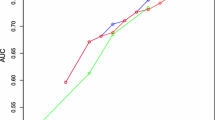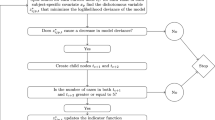Abstract
Preference rankings usually depend on the characteristics of both the individuals judging a set of objects and the objects being judged. This topic has been handled in the literature with log-linear representations of the generalized Bradley-Terry model and, recently, with distance-based tree models for rankings. A limitation of these approaches is that they only work with full rankings or with a pre-specified pattern governing the presence of ties, and/or they are based on quite strict distributional assumptions. To overcome these limitations, we propose a new prediction tree method for ranking data that is totally distribution-free. It combines Kemeny’s axiomatic approach to define a unique distance between rankings with the CART approach to find a stable prediction tree. Furthermore, our method is not limited by any particular design of the pattern of ties. The method is evaluated in an extensive full-factorial Monte Carlo study with a new simulation design.







Similar content being viewed by others
References
Amodio, S., D’Ambrosio, A., & Siciliano, R. (2016). Accurate algorithms for identifying the median ranking when dealing with weak and partial rankings under the Kemeny axiomatic approach. European Journal of Operational Research, 249(2), 667–676.
Ben-Israel, A., & Iyigun, C. (2008). Probabilistic distance clustering. Journal of Classification, 25, 5–26.
Böckenholt, U. (2001). Mixed-effects analysis of rank-ordered data. Psychometrika, 77, 45–62.
Bradley, R. A., & Terry, M. A. (1952). Rank analysis of incomplete block designs, I. Biometrika, 39, 324–345.
Breiman, L., Friedman, J. H., Olshen, R. A., & Stone, C. J. (1984). Classification and regression trees. Belmont, CA: Wadsworth International Group.
Busing, F. M. T. A. (2009). Some Advances in Multidimensional Unfolding. Doctoral Dissertation, Leiden, The Netherlands: Leiden University.
Busing, F. M. T. A., Groenen, P. J. F., & Heiser, W. J. (2005). Avoiding degeneracy in multidimensional unfolding by penalizing on the coefficient of variation. Psychometrika, 70, 71–98.
Busing, F. M. T. A., Heiser, W. J., & Cleaver, G. (2010). Restricted unfolding: Preference analysis with optimal transformations of preferences and attributes. Food Quality and Preference, 21, 82–92.
Carroll, J. D. (1972). Individual differences and multidimensional scaling. In R. N. Shepard, et al. (Eds.), Multidimensional scaling theory (Vol. I, pp. 105–155). New York: Seminar Press.
Chapman, R. G., & Staelin, R. (1982). Exploiting rank order choice set data within the stochastic utility model. Journal of Market Research, 19, 288–301.
Cheng, W., Hühn, J., & Hüllermeier, E. (2009). Decision Tree and Instance-Based Learning for Label Ranking. Proceedings ICML-2009, 26th International Conference on Machine Learning, pp. 161–168, Montreal.
Coombs, C. H. (1950). Psychological scaling without a unit of measurement. Psychological Review, 57, 145–158.
Coombs, C. H. (1964). A theory of data. New York: Wiley.
Critchlow, D. E. (1985). Metric methods for analyzing partially ranked data (Vol. 34)., Lecture Notes in Statistics Berlin: Springer.
Critchlow, D. E., Fligner, M. A., & Verducci, J. S. (1991). Probability models on rankings. Journal of Mathematical Psychology, 35, 294–318.
Croon, M. A. (1989). Latent class models for the analysis of rankings. In G. De Soete, et al. (Eds.), New developments in psychological choice modeling (pp. 99–121). North-Holland: Elsevier.
D’Ambrosio, A. (2008). Tree-based methods for data editing and preference rankings. Doctoral dissertation. Naples, Italy: Department of Mathematics and Statistics. http://www.fedoa.unina.it/2746/.
D’Ambrosio, A., Amodio, S., & Iorio, C. (2015). Two algorithms for finding optimal solutions of the Kemeny rank aggregation problem for full rankings. Electronic Journal of Applied Statistical Analysis, 8(2), 198–213.
Diaconis, P. (1988). Group Representations in Probability and Statistics. Hayward, CA: Institute of Mathematical Statistics.
De’ath, G. (2002). Multivariate regression trees: A new technique for modeling species-environment relationships. Echology, 83(4), 1105–1117.
Ditrich, R., Hatzinger, R., & Katzenbeisser, W. (1998). Modelling the effect of subject-specific covariates in paired comparison studies with an application to university rankings. Journal of the Royal Statistical Society C, 47, 511–525.
Ditrich, R., Katzenbeisser, W., & Hatzinger, R. (2000). The analysis of rank order preference data based on Bradley-Terry Type models. OR Spectrum, 22, 117–134.
Dusseldorp, E., & Meulman, J. J. (2004). The regression trunk approach to discover treatment covariate interaction. Psychometrika, 69(3), 355–374.
Emond, E. J., & Mason, D. W. (2000), A new technique for high level decision support. ORD project Report PR2000/13 Department of National Defence, Canada.
Emond, E. J., & Mason, D. W. (2002). A new rank correlation coefficient with application to the consensus ranking problem. Journal of Multi-Criteria Decision Analysis, 11, 17–28.
Feigin, P. D., & Cohen, A. (1978). On a model for concordance between judges. Journal of the Royal Statistical Society, B, 40(2), 203–213.
Fligner, M. A., & Verducci, J. S. (1986). Distance based ranking models. Journal of the Royal Statistical Society, Series B, 48, 359–369.
Fligner, M. A., & Verducci, J. S. (1988). Multistage rankings models. Journal of the American Statistical Association, 83, 892–901.
Francis, B., Dittrich, R., Hatzinger, R., & Penn, R. (2002). Analysing partial ranks by using smoothed paired comparison methods: An investigation of value orientation in Europe. Applied Statistics, 51, 319–336.
Fürnkranz, J., & Hüllermeier, E. (2011). Preference learning. Berlin: Springer.
Gormley, I. C., & Murphy, T. B. (2008). Exploring voting blocs within the Irish electorate: A mixture modeling approach. Journal of the American Statistical Association, 103, 1014–1027.
Gormley, I. C., & Murphy, T. B. (2008b). A mixture of experts model for rank data with applications in election studies. The Annals of Applied Statistics, 4(2), 1452–1477.
Gross, O. A. (1962). Preferential arrangements. The American Mathematical Monthly, 69, 1–4.
Hastie, T., Tibshirani, R., & Friedman, J. H. (2009). The Elements of Statistical Learning. New York: Springer.
Heiser, W. J. (2004). Geometric representation of association between categories. Psychometrica, 69(4), 513–545.
Heiser, W.J., & D’Ambrosio, A. (2013). Clustering and prediction of rankings within a Kemeny distance framework. In B, Lausen, D., Van den Poel, Ultsch, A. (Eds.), Algorithms from and for Nature and Life, Springer series in Studies in Classification, Data Analysis, and Knowledge Organization, 19-31, Springer International Publishing Switzerland.
Heiser, W. J., & De Leeuw, J. (1981). Multidimensional mapping of preference data. Mathématiques et Sciences Humaines, 19, 39–96.
Inglehart, R. (1977). The silent revolution: Changing values and political styles among Western Publics. Princeton, NJ: Princeton University Press.
Kemeny, J. G. (1959). Mathematics without numbers. Daedalus, 88, 577–591.
Kemeny, J. G., & Snell, L. (1962). Mathematical models in the social sciences. Boston: Ginn and Company.
Kendall, M. (1948). Rank correlation methods. London: Charles Griffin & Company Limited.
Larsen, D. R., & Speckman, C. L. (2004). Multivariate regression trees for analysis of abundance data. Biometrics, 60, 543–459.
Lee, P. H., & Yu, P. L. H. (2010). Distance-based tree models for ranking data. Computational Statistics and Data Analysis, 54, 1672–1682.
Luce, R. D. (1959). Individual choice behavior. New York: Wiley.
Mallows, C. L. (1957). Non-null ranking models, I. Biometrika, 44, 114–130.
Marden, J. I. (1995). Analyzing and modelling rank data. London: Chapman & Hall.
Meulman, J. J., Van Der Kooij, A. J., & Heiser, W. J. (2004). Principal components analysis with nonlinear optimal scaling transformations for ordinal and nominal data. In D. Kaplan (Ed.), The SAGE handbook of quantitative methodology for the social sciences (pp. 49–70). Thousand Oaks: Sage.
Murphy, T. B., & Martin, D. (2003). Mixtures of distance-based models for ranking data. Computational Statistics and Data Analysis, 41(3), 645–655.
Nerini, D., & Ghattas, B. (2007). Classifying densities using functional regression trees: Applications in oceanology. Computational Statistics and Data Analysis, 51, 4984–4993.
Siciliano, R., & Mola, F. (2000). Multivariate data analysis and modelling through classification and regression trees. Computational Statistics and Data Analysis, 32, 285–301.
Skrondal, A., & Rabe-Hesketh, S. (2003). Multilevel logistic regression for polytomous data and rankings. Psychometrika, 68(2), 267–287.
Strobl, C., Malley, J., & Tutz, G. (2009). An introduction to recursive partitioning: rationale, application, and characteristics of classification and regression trees, bagging, and random forests. Psychological Methods, 14(4), 323–348.
Strobl, C., Wickelmaier, F., & Zeileis, A. (2011). Accounting for individual differences in Bradley-Terry models by means of recursive partitioning. Journal of Educational and Behavioral Statistics, 36(2), 135–153.
Thurstone, L. L. (1927). A law of comparative judgment. Psychological Review, 34, 273–286.
van Blokland-Vogelesang, R. (1990), Unfolding and group consensus ranking for individual preferences. Unpublished PhD thesis, University of Leiden.
Van Deun, K., Heiser, W. J., & Delbeke, L. (2007). Multidimensional unfolding by nonmetric multidimensional scaling of Spearman distances in the extended permutation polytope. Multivariate Behavioral Research, 42, 103–132.
Vermunt, J. K. (2003). Multilevel latent class models. Sociological Methodology, 33(1), 213–239.
Acknowledgments
The authors would like to thank anonymous reviewers for their helpful comments, which have helped us to greatly improve the quality of this manuscript.
Author information
Authors and Affiliations
Corresponding author
Rights and permissions
About this article
Cite this article
D’Ambrosio, A., Heiser, W.J. A Recursive Partitioning Method for the Prediction of Preference Rankings Based Upon Kemeny Distances. Psychometrika 81, 774–794 (2016). https://doi.org/10.1007/s11336-016-9505-1
Received:
Revised:
Published:
Issue Date:
DOI: https://doi.org/10.1007/s11336-016-9505-1




